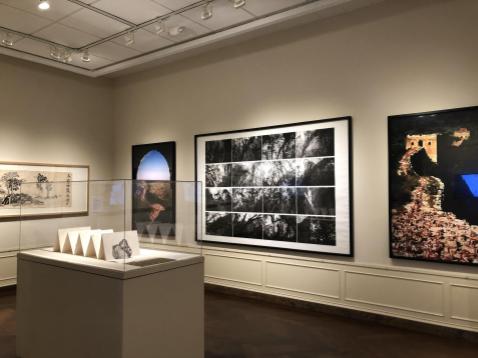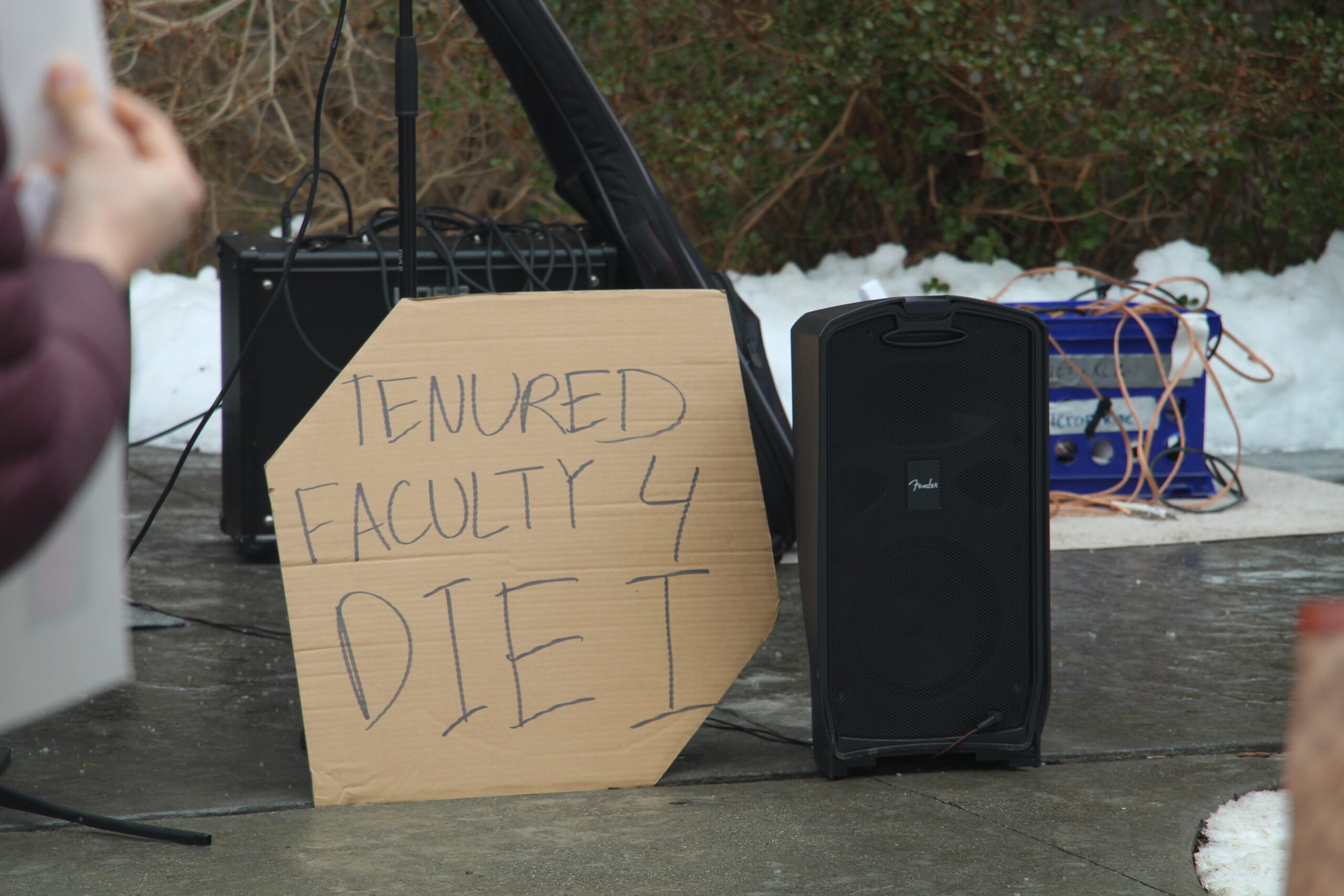New London’s Lyman Allyn Museum is currently hosting the not-to-be-missed Chinese Landscape Rethought exhibition. Yibing Huang, renowned Chinese poet and East Asian studies professor at Connecticut College, curated the exhibition and carefully selected eleven distinguished Chinese contemporary artists to be featured. Although different in their approaches, all of the works exhibit a unique convergence of the traditional Chinese landscape practice of shanshui (山水, which directly translates to mountain and water) with more experimental, unorthodox elements. There are many underlying themes associated with the artwork, like that of East meets West, reimaginations of language and nature, suppression of cultural histories and identities, and other global, contemporary issues. On April 12th, Connecticut College students and faculty as well as locals gathered for the museum’s Chinese Landscape Rethought Artist Symposium, where five of the featured artists came in to discuss their personal artistic histories. This review only covers the work of the artists that attended the symposium, but all of the art present at the exhibition is equally as nuanced and thought-provoking.
One of the more provocative works is a three-paneled, mixed media piece titled Muted Landscape. The artist of the installation, Guo Zhen, presents a kind of “anti-landscape” to call into question the long-standing patriarchal order of ink art and literati shanshui. A sort of washed-out variation of a Chinese landscape serves as the background for the several severed breast molds overlaid on top. For Guo, a female’s breasts represent strength, emotion, and sensitivities but at the same time elicit feelings of sadness and despair. Mothers suffer so much — through childbirth, sacrifice for the family, and prejudice against women — yet are still expected to remain strong. These breast molds are a theme present in many of Guo’s works, where another series, although not present in the current exhibition but discussed at the symposium, includes punching bags fitted with similar, multi-cultural breasts molds to depict an especially powerful message. The juxtaposition of the punching bags with breasts shows their physical incompatibility, yet the imagery of the two forced together well articulates the history of emotional abuse, silenced voices, and overall oppression of females. The concept of the underappreciated mother can also be extended to our Mother Earth. With regard to both our familial mothers and natural Mother Earth, Guo asks us to consider the following: “She sustains us, yet how do we respect her?”
Zhang Hongtu specializes in creating unique hybrids of East-West practices as well as reproducing famous centuries-old Chinese art with a more contemporary twist. One of his pieces on display, titled Shitou-Van Gogh M, resembles a traditional Chinese ink painting scenery, but utilizes the Western preferred medium of oil paint and Van Gogh’s post-impressionist style to create a rather striking and unique look. Zhang has always had an interest in other cultures as well as the ways in which cultures interrelate and overlap. Moving to New York City was an especially revelatory moment for him, as he found creative inspiration from the city’s celebration of diversity. Zhang rejects the artificial limitations that sometimes bind art and cultures; instead he insists that all cultures can and should coexist. He therefore hopes to inspire a dialogue between cultures with his hybrid series. The other works by Zhang are also conversation pieces. His Remake of Ma Yuan’s Water Album X is part of a larger body of work that cleverly reproduces the beautiful shanshui scenes of Song dynasty painter, Ma Yuan, but with a more contemporary, critical eye. Although perhaps not readily apparent, the “foam” covering the surface of the water is actually a coating of the chemical pollution now pervading our oceans.
Zheng Lianjie’s highly acclaimed Huge Explosion: Binding the Lost Souls dramatically displays a sea of red ribbon-tied stones distributed along a ruined section of the Great Wall. This grand gesture paid tribute to the “wounded histories and memories … of the anonymous ‘lost souls.’” Zheng has also spent months at a time residing in various mountains, most notably the sacred Daoist Mt. Hua, to refocus his attention toward improving his inner calm as well as to broaden his vision of the world. He emphasized that he was living within and not escaping to the mountains — a differentiation he deemed important because freedom is at the soul of his art. A slow casting off of leaves into the wind or a days-long endeavor of blanketing the earth with snowballs (two video performance projects of his Mt. Hua series), showcase Zheng renewed in a liberated and more meditative state.
Natural elements, like that of leaves, twigs, seeds, and thorns, are central to Cui Fei’s Manuscript of Nature series. These gathered materials are meticulously arranged, then fixed to paper or transferred onto panels to resemble an abstract version of traditional Chinese manuscripts. For Cui, assembling these manuscripts enables her to regain a sense of control and order during more turbulent times. Cui’s work, although largely modeled after Chinese calligraphic script, transcends cultural and linguistic boundaries. A reading of these manuscripts reminds us that we can always turn to nature, with its inherent calmness and tranquility, as a place of refuge and revitalization. Like Chinese characters, which became abstracted from their nature-based ideogram origins, Cui asserts that “humans have also detached themselves from nature.” Many of us however would benefit from re-establishing a better relationship with nature. More of Cui Fei’s work is on display in Shain Library’s Charles Chu Asian Art Reading Room at Connecticut College as a separate solo exhibition titled Cui Fei: Counter-Monument, which runs until April 30th.
Like the other shanshui artists, Wang Mansheng’s Mt Wangmu series also attempts to inspire greater environmental consciousness. He expressed great discontent with the way in which our society “chokes the earth,” covering our natural lands with concrete only to create “cities buried with human garbage.” In such a littered and chaotic world, it’s difficult to find a quiet moment or a place of solace. Wang’s imagined versions of mountain landscapes not only provide a temporary escape from this reality but also encourage discussion of how we can reconnect with and restore our environment. Wang also acknowledged the little-to-no human presence in shanshui — an intentional omission that symbolically serves to keep the natural landscape clean, free of human intervention (and destruction). Deep-rooted in ancient Chinese philosophy is an emphasis on the interconnectedness and harmony between nature and humans. Admittedly the Chinese have strayed from their original relationships with nature, prioritizing economic development and urbanization over natural preservation. The Chinese aren’t alone, though, in what has virtually become a global phenomenon of unrestrained consumption and (ethics-free) capital accumulation. These shanshui works thus promote a kind of call to action, asking us to reorient our outlook and behaviour to better prioritize our natural environment.
Chinese Landscapes Rethought ends on June 9, so go check it out while you can. I promise, it will not disappoint.










